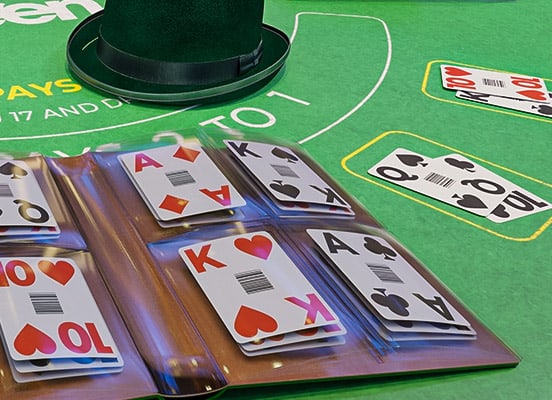Die Zahlen hinter „Paare teilen“
Es gibt drei gute Gründe, Ihre Paare zu teilen. Alle laufen auf einen verringerten Hausvorteil hinaus. Der erste Grund ist, eine Hand mit guten Gewinnchancen durch die Teilung in zwei Hände mit guten Gewinnchancen zu verwandeln. Der zweite Grund ist, Verluste auf lange Sicht zu verringern, wenn die Chancen ohne Teilung noch schlechter wären. Der dritte Grund ist, eine Hand mit schwachen Gewinnchancen durch die Teilung in zwei Hände mit besseren Aussichten zu verwandeln. Lassen Sie uns gemeinsam die Beispiele anschauen, die die einzelnen Fälle verdeutlichen.
Den Gewinn bei vielversprechenden Händen vervielfachen
Angenommen Sie sitzen an einem Spieltisch, bei dem acht Kartenstapel eingesetzt werden und die Regeln nach dem Teilen keine Verdoppelung zulassen. Sie erhalten die Hand 9 – 9, während der Dealer eine 6 hat. Ihr Handwert beträgt 18 und ist gegen die 6 vom Dealer in einer guten Ausgangsposition. Wenn Sie in diesem Fall einfach auf der Hand stehen bleiben, werden Sie in 64 % der Fälle gewinnen. Sollten Sie 100 Mal in diese Position geraten und jedes Mal € 1,- setzen, würden Sie im Schnitt € 28,- Gewinn erzielen. 64 von 100 Mal würden Sie gewinnen und dabei € 64,- verdienen, während Sie 36 Mal verlieren und dabei € 36,- Verlust haben. Die Differenz zwischen den beiden Beträgen beträgt € 28,- (€ 64,- – € 36,-).
Obwohl das ein schöner Gewinn ist, können Sie mit einer Teilung Ihrer Starthand durchschnittlich
€ 40,- Reingewinn in 100 Runden erzielen und damit € 12,- mehr. Durch die Teilung des Paares verschlechtern sich zwar die Gewinnchancen Ihres einen Blattes von 64 % auf 60 %. Da Sie nun aber zweimal eine 60%ige Gewinnchance haben, gewinnen Sie auf die Dauer höher.
Wenn Sie die Hand 100 Mal spielen, werden Sie im Durchschnitt 60 Mal gewinnen. Da Sie jetzt aber zwei Hände spielen, machen Sie dabei einen Gewinn von € 120,- (€ 2,- * 60). Die übrigen 40 Mal werden Sie verlieren und bei doppelten Einsatz insgesamt € 80,- (€ 2,- * 40) Verlust haben. Daraus ergibt sich ein Gewinn von € 40,- (€ 120,- – € 80,-). Das sind € 12,- mehr als in unserer vorherigen Berechnung, in der Sie stehen geblieben sind und bloß € 28,- gewonnen haben.
Verluste in aussichtslosen Händen verringern
Sie spielen weiter am Tisch mit 8 Kartenstapeln, aber diesmal erhalten Sie die Hand 7 – 7, während der Dealer eine 2 hat. Ihr Handwert von 14 ist nicht gerade vielversprechend. Durchschnittlich werden Sie bei dieser Konstellation in 64 % aller Fälle verlieren und nur in 36 % gewinnen. Wenn Sie 100 solcher Hände spielen und immer € 1,- setzen, werden Sie am Ende € 28,- verloren haben
(€ 36,- – € 64,-).
Wenn Sie Ihr Paar teilen, erhalten Sie zwei Hände mit einem Wert von 7. Sie haben zwar weiterhin schlechte Aussichten, die Hand zu gewinnen, aber Ihre Chancen haben sich im Gegensatz zu Situation vor der Teilung dennoch verbessert. Im Schnitt werden Sie 55 % ihrer Spiele bei dieser Konstellation verlieren und 45 % davon gewinnen. Wegen der Teilung haben Sie einen zusätzlichen Einsatz auf dem Tisch platzieren müssen. Sie setzen also in diesem Beispiel € 2,-. Das bedeutet, Sie würden in 100 Händen € 90,- gewinnen (€ 2,- * 45) und € 110,- verlieren (€ 2,- * 55). Daraus ergibt sich insgesamt ein Verlust von € 20,- (€ 90,- – € 110,-). Verglichen mit den € 28,-, die Sie ohne Teilung des Paares verlieren würden, machen Sie also € 8,- weniger Verlust.
Hände mit schlechten Chancen in Hände mit guten Chancen verwandeln
Nehmen wir an, Sie sitzen weiterhin am gleichen Tisch und erhalten wieder 7 – 7. Doch diesmal hat der Dealer eine 6. Obwohl die 6 für Sie besser ist, als die 2 im vorherigen Beispiel, sind Ihre Chancen auf einen Gewinn weiterhin gering. Auf lange Sicht werden Sie bei dieser Konstellation Geld verlieren. Im Schnitt werden Sie in 42 % aller Fälle die Hand gewinnen und in den übrigen 58 % verlieren. Wenn Sie 100 Hände mit einem € 1,- Einsatz spielen, werden Sie im Schnitt € 16,- (€ 42,- – € 58,-) dabei verlieren.
Indem Sie die Siebenen teilen, können Sie den Vorteil allerdings zu Ihren Gunsten verändern. In diesem Fall hätten Sie keinen Kartenwert von 14 mehr vor sich liegen, sondern zwei Mal die 7. Die 7 gewinnt auf lange Sicht gegen die 6 vom Dealer. Nach der Teilung haben Sie eine Chance von 52 %, die Hand zu gewinnen. In 48 % der Fälle werden Sie verlieren. Da Sie einen zusätzlichen Einsatz setzen müssen, werden Sie im Schnitt € 104,- gewinnen (€ 2,- * 52) und € 96,- verlieren (€ 2,- * 48). Daraus ergibt sich insgesamt ein Gewinn von € 8,- (€ 104,- – € 96,-). Dank der Teilung Ihrer Hand haben Sie aus € 16,- Verlust einen Gewinn von € 8,- gemacht.
